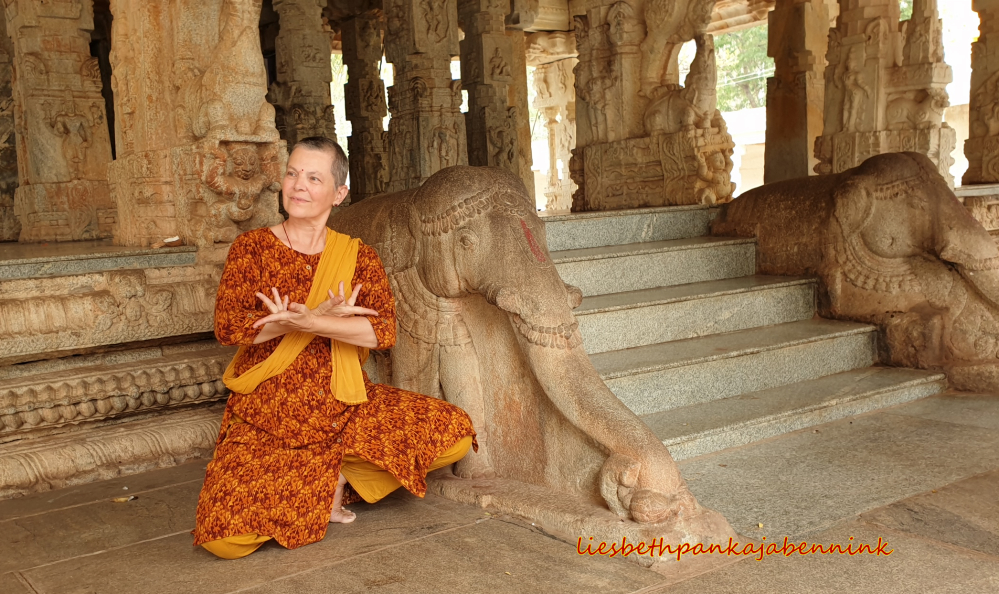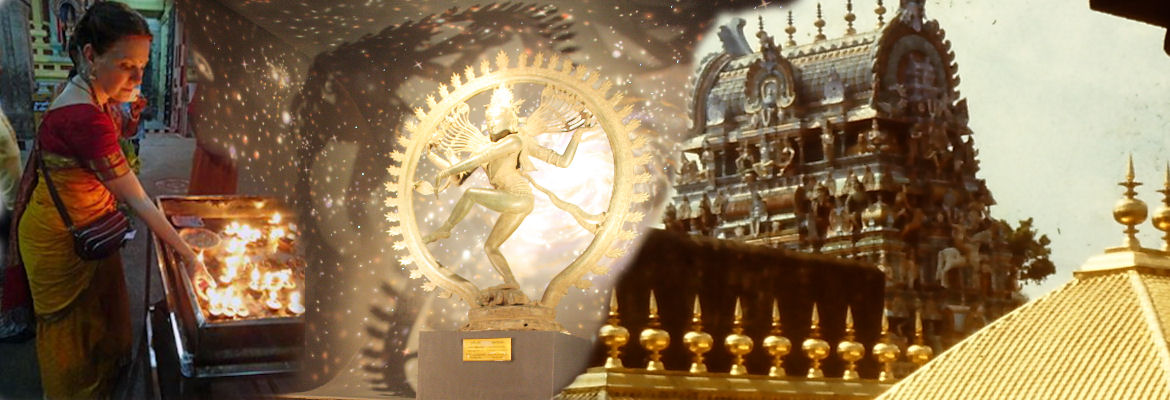In the summer of 2019, I was invited to share something about my connection to India and Indian culture for the Deepavali edition of the renowned Marathi publication Prasad Prakasan. The invitation came from Smt.Uma Joshi-Bodas, editor, through the researcher Nilesh Nilkanth Oak. I was honored and happy to undertake this. Below you can read how I was inspired to undertake my journey into the treasures of ancient and modern India. How I became a Bharata Natyam dancer and how I was enriched and blessed through this ancient nation and its treasures of art and knowledge. How I was inspired to ‘Dancing with my Hands’ Here you can read the Marathi translation made by Smt.Uma Joshi-Bodas and published in Prasad Prakasan.

Dancing with my hands
Watching early evening television together with my father, I was mesmerized by the elegant and intricate dance movements performed by a beautifully dressed lady on the small black and white screen. From my 4th birthday I had been in Ballet class and dancing had become my primary language of expression. On any and every occasion I danced spontaneously with every emotive tune I heard. Or even when there was no music. I moved and danced flowing through and with the sounds and feelings taking hold of me. But the dance technique of classical Ballet doesn’t have any place for the hands. Even though the hands are the most intensively used limbs of the human body, after the tongue. Our hands make us humans’ creators. They make us what and how we are, even before language. In Ballet hands only play the role of inert auxiliary appendices.
I was awe-struck by this lady dancing with bells on her ankles and telling stories with her hands. I was hooked then and there. A few months later I saw it again, this time during a school outing to the local Ethnological Museum. My school class was treated to a screening of the short documentary film “Lord Shiva Danced” (1948) featuring Ram Gopal and several dancers representing the various dance languages of India. One of the dancers danced the opening of a lotus flower and bees hovering over it, just with his hands and eyes. The brief episode has been indelible in my memory ever since.
I begged my mother, could I learn this Indian dance? PLEASE! She did her very best, asked my Ballet school, asked around. But in Rotterdam in the mid-sixties it just wasn’t there. As time passed my longing slowly sank away, into my unconscious mind. Never completely gone.
Fast forward to today. My name is Liesbeth Pankaja Bennink, and I introduce myself as Bharata Natyam dancer and historian. I received my Bharata Natyam training from Smt. Rajamani Knols (Amsterdam, Bombay, Bangalore), who was a disciple of K.P.Kitappa Pillai and did my arangetram in 1981. In 1983 I finalized my M.A. in history at the Rijksuniversiteit of Utrecht. The ultimate experience of my life was when I offered my dance before Lord Nataraja at the Shri Shiva Nataraja temple in Chidambaram.
When I first came to India some 40 years ago, I was primarily motivated by curiosity and eagerness. My guru took me by the hand, I felt like a little girl, she took so good care of me. From her teaching and from that first experience I gained a feeling of the unfathomable depth and treasure of its civilization.
For a while I also experienced a bit of confusion. My personal experience with the Indian civilization through learning the tradition as a dancer was one of great depth and sophistication. On the other hand, when I read academic literature as a historian, the impression raised was one of a land mired in superstitions and conflict. My confusion was resolved through my close connection with my friend and teacher, the late R.N.Natarajarathina (Raja) Deekshithar M.A. (1949-2010) and the time I spend with him and his family in Chidambaram. Experiencing the life of a Brahmin community within a Dravidian environment I realized the whole Aryan Invasion Theory and all it was assumed to teach us about Indian civilization was rubbish. It was an intuition which eventually came to be supported by my research and factfinding.
Now my relationship with India is marked by gratitude, as my life has been enriched and has been so very interesting due to my involvement with India and its arts, sciences and history. I learned so much, still learning every day. As my Bharata Natyam guru Rajamani-akka used to say, from the ocean of knowledge a person cannot even drink one full glass in a life-time. To me it is a Grace to have become part of this great civilization.
As I have come to understand history the whole world benefits from India’s treasure trove of knowledge and wisdom. Many sciences first evolved here, mathematics, geometry, astronomy, linguistics, medicine, philosophy. This is not generally acknowledged, because of ignorance and prejudice. One of my life-goals is to open people’s eyes to this. Not only the people outside India. But today’s people of India itself. Because of the wounding caused by the 150 years of colonial occupation, exploitation and the contempt with which the occupiers treated India and its people. The Jewel in their crown! These colonial attitudes and practices continue to grip India where many lack knowledge of their own history and heritage and have been caught up in these colonial prejudices.
It is part of the human condition to be wounded by our experiences. It is also our common challenge as human beings to strive to heal ourselves. At the same time much of what we see as “progress” around us has roots in what India has gifted humanity. And these gifts, such as an unbroken oral tradition, understanding of Dharma as responsibility, but also technology, philosophy, science, and the arts, can be applied for healing as easily as for destruction. The reality is that this gem of a planet of ours is just a village now, we are living and healing together. No other go.
As we strive to apply wisdom we hope to avoid the errors of the past, and may thus avoid errors of the future, by contemplating Dharma, which is as simple as doing what is right.
This is a challenge for humanity as a whole. Nation-State borders are fast becoming an illusion. Lines drawn by ethnicity, gender, language, creed, identity, aren’t they all illusion? Oppositions and animosities more imagined then anything else. Through our human biology and consciousness, we are ONE with 1 challenge: to realize our humanity and divinity.
Dance unites us because body language is rooted in our biology, in our Annamaya Kosha. As the language of the body, dance evolved before the language of speech, words, and grammar. I have always carried the hope and expectation in my heart that Indian dance would be part of the world civilization which is now emerging. Because the language of dancing with hands is universal. We need such unifying forces, as there are powers at work who put humanity against itself, for profit.
In the words of one wise man who was one of the leaders of the Dutch social justice movement in the 20th century, Floor J. Wibaut (1859-1936).
Er is maar één land: de aarde
Er is maar één volk: de mensheid
Er is maar één geloof: de liefde
There is just one land: the earth
There is just one nation: humanity
There is just one creed: love
My father had these words calligraphed and hung on our living room wall. As I grew up, I read and thought about them a lot. They deeply influenced me as they are so true. They also express the truth of what in India is called advaita. Ultimately all is ONE. All separateness is illusion. As I dance, telling the ancient stories, talking about the ancient wisdom of India, I share this treasure.
© 2019 Liesbeth Pankaja Bennink
The Netherlands

Seetha
Hi, I Saw you dancing in the dom Church in Utrecht when I was 18, was immediatly hooked! I took up bharat natyam when I was 21, my teacher was Gert van leeuwen, student of professor C.V. Chandrasekhar. I completer in 9 years my training after joining professor in Baroda,India.
After my arrangetram I wrote a book on Bharata natyam, de dans van India, which is used in a lot of dancing schoolkinderen the netherlands, belgium and Suriname.
Unfortunately I cannot dance anymore, but I Am still very interested in dance and its history. I nowmake art with dance as inspiration.
Kathleen Ball Ph D
So beautiful, you’ve touched my soul with your words Liesbeth. We share similarities in our deep belief in oneness developed in childhood, inspired by our fathers. I’m very thankful to have you in my life as a dear friend.